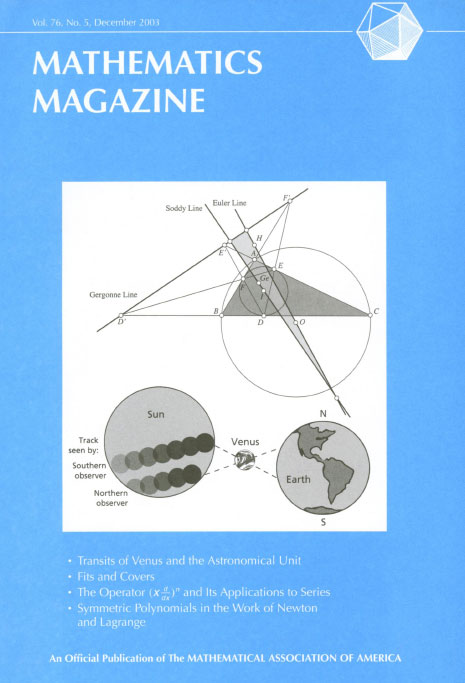- About MAA
- Membership
- MAA Publications
- Periodicals
- Blogs
- MAA Book Series
- MAA Press (an imprint of the AMS)
- MAA Notes
- MAA Reviews
- Mathematical Communication
- Information for Libraries
- Author Resources
- Advertise with MAA
- Meetings
- Competitions
- Programs
- Communities
- MAA Sections
- SIGMAA
- MAA Connect
- Students
- MAA Awards
- Awards Booklets
- Writing Awards
- Teaching Awards
- Service Awards
- Research Awards
- Lecture Awards
- Putnam Competition Individual and Team Winners
- D. E. Shaw Group AMC 8 Awards & Certificates
- Maryam Mirzakhani AMC 10 A Awards & Certificates
- Two Sigma AMC 10 B Awards & Certificates
- Jane Street AMC 12 A Awards & Certificates
- Akamai AMC 12 B Awards & Certificates
- High School Teachers
- News
You are here
Transits of Venus and the Astronomical Unit
Transits of Venus and the Astronomical Unit

The transit of Venus over the Sun will be visible in much of the Western Hemisphere on June 5-6, 2012. To celebrate this event, the MAA has made "Transits of Venus and the Astronomical Unit" by Donald A. Teets (South Dakota School of Mines & Technology) available to the public.
This article was originally published in the December 2003 issue of Mathematics Magazine.
Read the full article (pdf).
The next pair of Transits of Venus will be December 11, 2117, and December 8, 2125. The June 5-6, 2012 transit is the second of a pair whose first transit occurred June 7-8, 2004.
Article Abstract
In the December 1771 edition of the Philosophical Transactions of the Royal Society of London, Thomas Hornsby wrote that ’the mean distance from the Earth to the Sun [is] 93,726,900 English miles.â? Amazingly, this distance differs from a modern radar-based value by a mere eight-tenths of a percent. Eighteenth century astronomers computed this distance, known as the astronomical unit, from the geometric configuration of the Earth, Venus, and the Sun during a rare astronomical event known as a transit of Venus. The method was suggested by Edmond Halley, and carried out by the English telescope maker James Short, among others. This article presents a glimpse into the very rich history surrounding observations of the transits of Venus, as well as a mathematical description of how the transits were used to determine the length of the astronomical unit.
For subscribers, read recent issues online (Requires MAA Membership)
Not a member? Join the MAA today!




